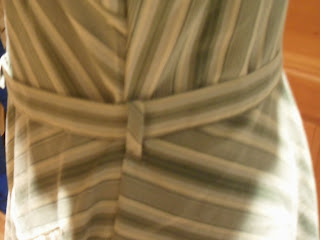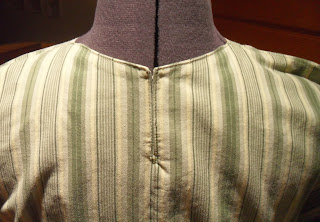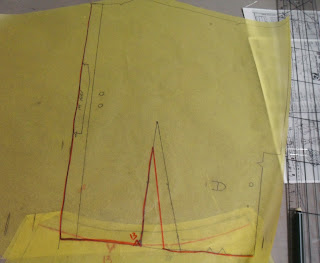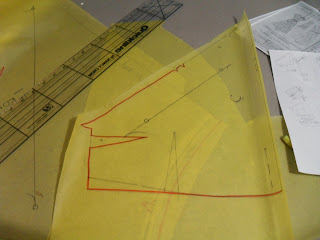And we have another green striped bias dress!
 |
| Too dark to see it properly, but the sections do line up to make a diamond. |
But back up a little: how did it go together?
To be honest, this stripe is not printed ongrain. It's off a little, so I matched by print. The fabric is an old bottom sheet I found at the thrift store. I had a vintage green striped dress I no longer fit that I loved and have been trying to recreate/make another one since then. This is attempt number three.
I had to pick a point on the stripes that I could use as 'true north' to even attempt to get that diamond shape match on the front skirt and bodice pieces. The pin is at that point, the top edge of the center of the front skirt panel, the little narrow yellow stripe in between the dark green ones. I will use that little yellow stripe as reference for the other bias bodice pieces.
From there, I swivel the pattern to get the grainline to line up on the stripes.
 |
| Pee Wee is always helping out! |
I cut the pieces out one by one.
I laid the first panel on top to match at the edges; figuring that would hold reasonably true all the way across.
Lining up pretty well.
This just continues for the other pieces. Go get a coffee, I'll still be matching.
Then there's a lot of sewing. I mess up the zipper. The back neck is too high. The waist droops. I cut out the wrong sizes for the front/back and realize this AFTER I have made the pretty bias pockets, lined them and sewn them on. There's just hours of seam unpicking. Watching an entire season of Trigun on Netflix with my son. Beats starting over and matching all those stripes again.
This bears repeating: if you've gone to all the trouble of cutting out something, and it goes together wrong, it really is worth it to pick it apart and redo it. If you let it go and wear it, you'll always see the error, it will always fit badly. And you'll hate it.
So pull up a chair and get a seam ripper with a strong, tiny point.
But while you're sewing those panels, doublechecking the stripe match at the seam just involves pinning them together, and then folding over at points to see if it's matching up. Sometimes sticking a pin through the tiny stripe and pulling it through to the matching tiny stripe, then pinning it; that works for me. If it doesn't, you can often wiggle it into place. Bias is forgiving for that, it will take some compression. You can also slide it from side to side to goose it into place. If you didn't cut it out right, it won't work. That's why you are supposed to cut wide seam allowances for this sort of thing. Hey, dug my own hole there.
I know, now we're at the hem. Which I BOUGHT bias tape for today, just one less thing to do. And the skinny poly stuff will take quite the heat beating. I went for 1 1/4 hem turnover, stitched the bias trim to it, and ironed/steamed it into a nice, well-behaved curve. I ironed open the single fold strip to one side, sewed it on, and then folded and ironed it on the table while turning the hem (didn't iron after attaching, didn't want to stretch it out).
Iron, slip cutting board strip under, pin.
Iron, pin, iron, pin; all the way around.
To drop the back neck, I undid the topstitching (facepalm), turned them open, and just cut one.
After I sewed the first one, I used the cut off part as a template for the second one.
I pinked a lot of things. I have a lot of vintage stuff that is just pinked and it's held pretty well. This is my tiny homage. That and a grosgrain ribbon in the interior waistband.
There's a gap between the back facing and the front neck facing.
So I made a bridge of batiste.
Machine stitched to the back facing.
Folded over
More ironing. So glad I bought that sleeve board last year, it's really good for tight spots.
Hand sewn in place. Repeated on other side.
And now we're done. Big button on tab foldover.
Button belt (hidden snap to hold it straight) as I don't have a belt buckle that works with this era.
This gives you a better idea of the real colors.
Bias tubing for belt loops at sides.
No matter what I do, the spot above the hook and loop closure always pulls away like that. I think it's my hamhanded hand sewing.
And that nifty pocket!
Would I make it again? Yes. I would cut the bodice a little shorter, take a little slack out of the front sleeve piece, and maybe put in a very light shoulder pad OR angle the shoulder seam down at the shoulder point.
And I will. Just maybe not in green again.





















































